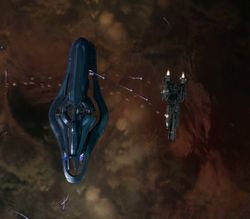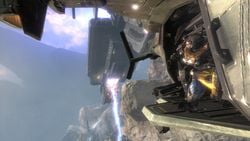Titanium-A armor
From Halopedia, the Halo wiki

Titanium-A armor is the most common form of battle plating used by the UNSC on its warships. It is composed of high-grade Titanium-50[1] that is specially strengthened at the molecular level,[2] which implies alloying with other elements. It is usually greyish in color, and at least in the case of destroyers is embedded with thermal superconducting radiators which are probably needed to protect the ship from a plasma that does not have its own magnetic field or has too weak. [note 1] [3] Following the Human-Covenant War, some UNSC military vessels received energy shielding to allow the ships to absorb more damage.[4] Like the Magnetic Accelerator Cannon, Titanium-A armor plating saw advances and widespread use due to the Insurrection.[5]
Characteristics
Applications

Titanium-A has numerous uses throughout the UNSC due largely to titanium being lightweight and extremely strong, with a high tolerance to heat. Its primary use is armor for ships. Typically, as much as one-third of a standard UNSC military vessel's mass is the Titanium-A plating.[2] UNSC frigates have sixty centimeters of plating on their hull, UNSC destroyers have up to two meters of plating and UNSC carriers have thirty-six centimeters of Titanium-A plating.[6] Marathon-class heavy cruisers have 191 centimeter-thick layers of Titanium-A armor, allowing them to sustain far greater damage.[7] D77-TC Pelicans[8] and GA-TL1 Longswords[9] are both covered in Titanium-A armor to provide additional protection in dogfights. Slipstream space probes are almost solid Titanium-A to allow them to survive the stresses of frequent slipspace entries and exits.[10] Long Range Stealth Orbital Insertion Pods are given additional Titanium-A plating to allow the pods to be launched from slipspace.[11] Refit stations[12] and construction platforms, such as Station Delphi, are essentially slabs of Titanium-A armor plating.[13]
The UNSC uses Titanium-A for construction of military bases as well, to make them less susceptible to destruction. Underground facilities such as HIGHCOM Facility Bravo-6, CASTLE Base[14] and Camp Hathcock used Titanium-A armor in their superstructures. Even lockers used by UNSC personnel are reinforced with a centimeter of Titanium-A armor plating.[15] Eridanus Secundus, a United Rebel Front asteroid base located in the Eridanus system, was reinforced with a layer of Titanium-A armor which also helps deflect UNSC and Covenant sensors.[16]
Defensive capabilities
Prior to the Human-Covenant War, a single Magnetic Accelerator Cannon slug was capable of penetrating any vessel's Titanium-A armor plating.[17] The armor took a newfound importance after the beginning of the Human-Covenant War: to contend with the Covenant's plasma weaponry, humans needed armor that would withstand the heat of the directed plasma. Despite its strength and resistance to heat, however, the Titanium-A plating is usually boiled away within seconds on contact with Covenant plasma torpedoes, and does not effectively dissipate the plasma. Energy projectors are able to pierce dozens of centimeters with relative ease.[2] Pulse laser turrets can reduce the hull of a Paris-class heavy frigate to about four centimeters in a single hit.[18] Even energy swords can do significant damage to Titanium-A armor.[19] During the Fall of Reach, the UNSC Grafton was destroyed by a single shot from the Long Night of Solace's energy projector.[20] Despite being armored with the stronger Titanium-A3 armor, the UNSC Infinity's hull was pierced by a Covenant mercenary space station's glassing cannon.[21] After three hits from the cannon, the Infinity was nearly destroyed.[22] However, the UNSC Savannah was able to hold its own for a while against the much larger Ardent Prayer, despite being severely outgunned.[23]
Molecularly-reinforced Titanium-A armor is typically employed alongside thick layers of elastic polymers and intermetallic laminate , allowing the host ship to mitigate both kinetic and energy-based attacks. The space between the armor plates is filled with shock-hardening fluids an encapsulated healing agents to reduce spall from impacts and automatically seal small hull breaches.[24] Titanium-A armor plating can be layered with tungsten for a radiation absorption rating of 5 and presumably grant greater protection against plasma weaponry.[25] Unlike the Covenant's nanolaminate hull plating, Titanium-A plating is not effective during direct collisions with other vessels. After a direct collision with a CPV-class heavy destroyer, the UNSC Spirit of Fire was heavily damaged, while the destroyer was seemingly unharmed.[26] When the destroyer UNSC Iroquois collided with a Covenant stealth ship, the Iroquois lost all two meters of Titanium-A plating, although it did succeed to disabling the Covenant vessel.[27]
Titanium-A3 armor
Titanium-A3 is a variant of Titanium-A battle plate developed by ONI's Materials Group. Like Titanium-A, it is chemically altered on the molecular level to produce a stronger plate for ship hulls. It has only been noted to be used on the UNSC Infinity, whose hull is composed of 4.9-meter-thick Titanium-A3 battleplate.[28]
Gallery
The UNSC Spirit of Fire is heavily damaged by a collision with a Covenant destroyer.
The UNSC Pillar of Autumn's modified hull is damaged by plasma turrets.
The UNSC Infinity's unshielded hull is pierced by a glassing station.
- ArabiaVostok.png
Two Charon-class frigates hulls are easily destroyed by plasma turrets.
A Longsword's hull is made up of Titanium-A armor.
A Marathon-class heavy cruiser's hull being pierced by a CAS-class assault carrier's energy projector.
- Superconducting solenoid.jpg
An example of the work of a superconducting solenoid in the journal of the USSR "Technology for the Youth" of 1963. Equivalent to lead armor 45 cm thick.
- Superconducting solenoid2.jpg
The principle of operation of a superconducting solenoid. "Technology for the Youth" 1963.
- UNSC Spirit Of Fire Superconducting.png
UNSC Spirit of Fire is in contact with the plasma of the star, which turns into a supernova and destroys the artificial planet.
- Destroyplanetburst.png
An explosion destroying the planet a few seconds after that.
Sources
- ^ Halo: Ghosts of Onyx, page 185
- ^ a b c Halo Encyclopedia, page 315
- ^ Halo Mythos, page 83
- ^ Spartan Ops, S1E1 Departure
- ^ Halo: Evolutions - Essential Tales of the Halo Universe, "The Impossible Life and the Possible Death of Preston J. Cole", page 457
- ^ Halo Encyclopedia, page 259
- ^ Halo: The Essential Visual Guide, page 42
- ^ Halo: First Strike, page 18
- ^ Halo: First Strike, page 40
- ^ Halo: First Strike, page 356
- ^ Halo: Ghosts of Onyx, page 13
- ^ Halo: The Fall of Reach, page 156
- ^ Halo: Ghosts of Onyx, page 51
- ^ Halo: First Strike, page 125
- ^ Halo: First Strike, page 55
- ^ Halo: First Strike, page 309
- ^ Halo: Contact Harvest, page 119
- ^ Halo: The Fall of Reach, page 129
- ^ Halo: First Strike, page 94
- ^ Halo: Reach, campaign level Tip of the Spear
- ^ Halo: Escalation, Issue 5
- ^ Halo: Escalation, Issue 6
- ^ Halo: Reach, campaign level Long Night of Solace
- ^ Halo: Warfleet - pg. 19
- ^ Halo: Evolutions - Essential Tales of the Halo Universe, "The Impossible Life and the Possible Death of Preston J. Cole", page 475
- ^ Halo Wars, campaign level Repairs
- ^ Halo: The Fall of Reach, pages 176-177
- ^ Halo 4 Limited Edition, Infinity Briefing Packet
Notes
- ^ The word "thermal" in the context probably mean the superconducting properties of carbon nanotubes that appear at temperatures from 3726 ° C. This means that due to their stability they can generate a powerful magnetic field. At the time of 2020, generators allow you to create a short-term magnetic field from 91.4 to 1200 Tesla (for comparison, the Earth's magnetic field: 0.5 · 10-4 Tesla), but can not hold it due to the lack of sufficiently strong materials.





